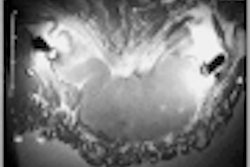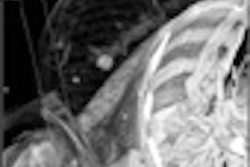Growing patient-safety concerns have put the world's watchful eyes on CT radiation exposure, and international efforts are underway to reduce dose and improve measurement techniques. At Stanford University’s 2001 International Symposium on Multidetector-Row CT in San Francisco, Dr. Mathias Prokop from the University of Vienna, Austria, showed how the ALARA principal -- i.e., doses that are "as low as reasonably achievable" -- works in daily practice.
"There are a number of dose parameters we should know about, but there are only two that are important: the CT dose index (CTDI), which indicates more or less the local dose, and effective dose, which indicates the overall radiation dose," Prokop said.
The CTDI volume (CTDI averaged over the x, y and z-axes) is the most accessible measurement. Just plug in a CT protocol and the CTDI volume can be read on every CT scanner in Europe (which has adopted strict dose controls), as well as a few in the U.S. (which has not yet done so).
From that point, calculating the effective dose from the CTDI volume gets cumbersome, Prokop said. But there's a trick that yields a rough estimate without all the calculations, at least for the chest. The effective dose for the chest is about half of the CTDI volume for females, and 40% for males.
The effective dose, a whole-body calculation based on atomic bomb survivor data, can be used to compare an exam dose to natural background radiation. A doctor can tell a patient that a chest CT will give him the equivalent of about a year and a half's worth of background radiation, making effective dose an effective communication tool. Prokop said the theoretical risk of death for a given effective dose varies by population, increasing for children, and decreasing for older individuals.
"An abdominal radiograph would give you 1.5 mSv, an IV urogram 2 mSv, and interventional procedures, depending on what you do, can give you up to 50 mSv, especially if you do a very complex procedure in the abdomen," he said. "If you look at chest CT, with an effective dose of 2-10 mSv, this will give you a calculated risk of death between one and five per 10,000 examined patients. In other words, one of your patients in 10,000 will, at least in theory, be killed from this exam."
Under European law, the volume CTDI must be under 30 mSv for the chest and abdomen. Recent data show that nearly all German facilities use between 5 and 20 mSv, well under the limit, he said. The U.S. is expected to adopt similar dose standards.
So how much lower is lower-dose CT? A good rule of thumb is to aim for a tenth to a twentieth of the guideline dose, yielding, for example, an exposure level of 2-3 mSv for the chest and abdomen, Prokop said.
"We want to cause as little harm to the patient as possible, even if this harm is only present on paper," he said. "I think a good way to do that is to classify the indications into three main categories: one is high-dose applications, the other is our standard applications, and then low-dose applications."
Dose applications
In high-dose applications, optimal image quality is critical for therapeutic decision-making -- the radiation risk being lower than the risk of misdiagnosis, Prokop said. High-dose applications are appropriate when a life-threatening disease is suspected, and the highest possible spatial resolution (both in-plane and along the z-axis) and contrast are required. Such applications are typically used for acute diseases such as the detection of mesenteric ischemia or the workup of side-branch complications of aortic dissection, malignant disease such as suspected pancreatic cancer, and preoperative staging of malignancies in the neck, chest or abdomen.
Most CT exams require standard-dose applications, used when good contrast -- but not optimal spatial resolution in all three planes -- is needed. Standard-dose applications produce high-quality axial images and an intermediate-quality CT dataset, Prokop said. They are appropriate for acute abdomen trauma, most vascular disease and tumors, and especially follow-up exams, where exposure becomes more important. Standard doses are typically used in lymphoma and abscess imaging.
Low-dose applications become practical when image-quality requirements are low, when the organ of interest can be evaluated discontinuously (as in HRCT for diffuse lung disease), when there is high contrast between the structures of interest and their surroundings (as in CT of the paranasal sinuses), or when the examined area has little x-ray absorption, such as in the imaging of children, the chest, or extremities. Low doses should be used for most screening exams, for benign disease, to acquire functional information, or if multiple follow-ups are needed, Prokop said.
X-ray absorption and mAs
All dose reduction techniques rely on reducing the effective mAs per section. This can be done by reducing mAs per revolution, per scan, or for a whole scan sequence, Prokop said.
Children and slim patients have lower x-ray attenuation than large patients, and therefore lower dose requirements. The same is true for organ regions with intrinsically low attenuation.
"For every 8 cm [additional] thickness of the patient, you have to basically double your [mAs] in order to get the same image quality," he said.
Dose reduction in high-contrast areas
Everyone knows that image noise and dose have an inverse relationship, Prokop said. What's interesting is that noise also depends on contrast, which can be reduced in intrinsically high-contrast regions such as the lungs, the skeleton, and the paranasal sinuses.
"When we have an opportunity to use wide window settings, and reduce the contrast, we can also reduce noise accordingly," he said. "If you go from a narrow to a wide window setting in soft tissues, then both contrast and noise go down."
Spatial resolution is largely determined by the reconstruction filter, high- or low-resolution. Choosing smoother reconstructions can reduce dose requirements as much as threefold, Prokop said.
"If you go to higher resolution, then you see that the dose requirements become excessive if you keep your noise at the same level," he said. "So these applications can only be used if you use a wide window setting and adjust accordingly. In clinical practice we often don't do it but we should do it: use a high-resolution kernel for the lungs and a smoothing kernel for the soft tissues."
Dose reduction with quality tradeoffs
The best-known dose-reduction technique, reducing mAs while keeping other settings constant, increases image noise. The effect can be offset by using more smoothing filter kernels for image reconstruction, Prokop said, creating a tradeoff between dose and in-plane spatial resolution.
Reconstructing thicker sections can also reduce image noise. This technique reduces z-axis resolution.
"Thinner sections allow less radiation to fall onto the detectors, and therefore image noise goes up dramatically," he said. If you reconstruct a 10-mm axial section, this noise can be reduced."
Thin collimation makes the best use of multislice CT's multiplanar capabilities. However, low-dose scanning can be accomplished by reconstructing an overlapping dataset of thin sections. The resulting images are noisy, but have high spatial resolution in all three directions, according to Prokop. Thick multiplanar reconstructions are then created in any desired plane, and the resulting MPR will have adequate signal-to-noise, with the only drawback being reduced through-plane resolution due to the thicker sections.
New scanner features
Online adaptive dose modulation, available in single-slice scanners but not yet in multislice scanners, yields excellent results in body regions where there is a marked difference in absorption between the anteroposterior and lateral diameters, including the shoulders, chest, abdomen, and pelvis in slim patients. This enables dose reductions of 10%-30%, depending on the shape of the examined body area.
Three-dimensional MDCT interpolation schemes aren't yet commercially available, but are being developed by Siemens and Toshiba, according to Prokop. These software features reduce noise without excessive data smoothing.
Longitudinal dose modulation programs vary the dose based on local requirements in the body, and represent an important step towards more consistent image quality, Prokop said.
"We need to do something about utilization of mAs. We should do it along the z-axis, because there's less attenuation in the neck, much more in the shoulders, less in the chest, and again increasing dose requirements in the pelvis. So we know that within one rotation there is a marked difference in absorption. There [are] also some efforts by Marconi, GE, and Philips for z-axis modification, and from GE and Siemens for the thin-slice modulation," Prokop said.
Low-dose guidelines
"For MDCT in kids, we should go down as low as possible," he said, showing a chest CT acquired at 120 kVp, 20 mAs effective dose, or about 2 mSv.
"This was the lowest dose we could use on our Siemens MSCT one year ago, but what we do now is something else," Prokop said. "If you go from 120 kVp to 80 kVp, the CTDI volume for the dose decreases by a factor of approximately 4. What happens is that the noise goes up substantially, but if you have a small kid this really doesn't matter."
What does matter, Prokop said, is that noise relative to CDTI volume is generally independent from the mAs for normal-sized children, and only in bigger kids does excessive noise make the use of 120 kVp mandatory. He recommended using 80 kVp and 20-40 mAs for newborns and infants, increasing to 40-80 mAs for children up to age 10.
"Larger kids need almost the same doses used in adults. You can see there is quite a range, and it depends, of course, on the size of the patient, and whether you examine just the chest or the abdomen [as well]," he said.
CT urography has intrinsic high contrast following the injection of contrast, and low-dose scans can be diagnostic if mAs settings are adjusted to patient size, in the range of 20-40 mAs effective dose. The group employs a thin-slab maximum-intensity projection (MIP) parallel to the course of the uterers, or thick MPR of 10 mm in the same direction to evaluate the images, Prokop said.
Moreover, low-dose protocols do an excellent job of detecting urolithiasis at a 20 mAs effective dose, allowing visualization of all therapeutically relevant stones larger than 2.5 mm in a water phantom. For obese patients, substantial dose increases, to 60-80 mAs, may be necessary.
"For colon cancer screening, we've already seen that the contrast between air and soft tissue is high, so marked dose reduction should be possible," he said. Using simulated polyps in a phantom, the group's ROC study showed no significant difference between the high dose (50 mAs) and the low-dose (20 mAs) exam for this purpose.
MDCT is also excellent for scanning bronchogenic cancer patients, since primary thin-section scanning allows for reconstruction of suspicious areas with a high spatial resolution, avoiding further scans in patients with detected nodules. Follow-up is also easier, especially when automated detection algorithms are used. Again, the mAs settings must be adjusted for patient size, and generally range between 10-40 mAs effective dose, or a weighted CTDI of 1-4 mGy.
"To summarize, low-dose MDCT is possible for kids, for the lungs, for screening exams, for urolithiasis, and CT urography. In order to reduce dose, we should scan with thin sections but reconstruct thick sections, either in [an] axial or multiplanar fashion," Prokop said. "We should use a proper reconstruction algorithm: the more smoothing the algorithm, the less dose you will need. The problem is that the smoothing algorithm will reduce your spatial resolution.... Trade off between those two effects, and then finally you should adapt to the patient's size, and use the newest dose-correlation techniques as soon as they become available."
By Eric BarnesAuntMinnie.com staff writer
July 25, 2001
Related Links
Council Directive 97/43/Euratom of 30 June 1997
Copyright © 2001 AuntMinnie.com



















